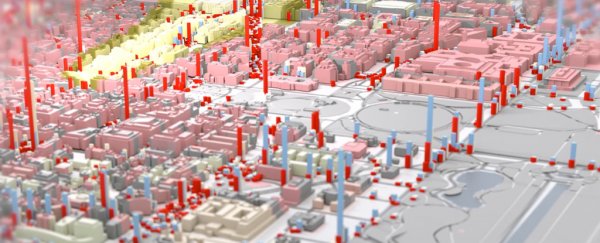To better understand how a nuclear blast would devastate major urban centres, researchers have created the ultimate equivalent of The Sims – a detailed computer model of Washington, DC, complete with its own personalised citizens.
We've all been there, creating digital cities that we joyfully smash apart. This one is less about entertaining our god-complexes, and more about testing real scenarios that we hope we never have to employ.
Computer scientists from the Biocomplexity Institute at Virginia Polytechnic Institute and State University (Virginia Tech) created a model of the US capital in unprecedented detail, down to individual personalities for each member of the population.
The institute has been helping the US Defense Threat Reduction Agency improve its models since 2007, and has been recently awarded a third five year contract to develop this new approach.
Exercises known as National Planning Scenario 1 (NPS1) used to look more like table-top role playing games, where government officials would try to predict the average actions of a population based on tables of statistics.
Computers have since helped speed up the calculations, allowing even non-officials like us to drop historical weapons on our neighbourhoods and see how far we'd need to run to escape.
This latest system leaves those programs in the dust.
Factors such as the spread of the fireball and the size of the fallout zone barely make up a fraction of the sum of information needed to keep citizens safe in the event of a nuclear attack.
Populations shift around throughout the day, for example, occupying buildings or public transport or even outdoor areas depending on the time and season.
Throw a devastating bomb blast into the mix, and their response could be anything from 'flee in panic' to 'stand paralysed with fear'.
In today's world, mobile communications networks play a central role in the distribution of information, further influencing how we all respond to news of an attack.
To allow national security experts to really get a solid understanding of how their emergency plans would play out in reality, the team at Virginia Tech really went to town by including everything from mobile cell towers to an accurate power grid.
In effect, this means a simulation could tell emergency planners what kind of mess to expect in terms of gridlock, power outages, and jammed communications.
Meanwhile, the sim-population – called 'agents' – are acting according to a generalisation of age, gender, and occupation, determining such behaviours as seeking out their family or blindly running in a panic.
"Agent-based models are how you get all these pieces sorted out and look at the interactions," computer scientist Christopher Barrett told M. Mitchell Waldrop at Science.
The concept itself isn't exactly groundbreaking, but until recently computers simply haven't been up to the task of handling all of the details of a city-sized simulation.
Even using up-to-date technology, this monstrous simulation keeps processors churning for a good day and a half.
With continued improvements in computing, though, we might expect those relatively simple-minded agents to develop in complexity.
Computer gaming aside, these types of simulation programs that determine group behaviours based on the actions of individual agents have been a serious goal for computer scientists for decades.
Epidemiologists have traditionally used simple equation-based systems that compartmentalise the population in an attempt to predict outbreaks, usually based on a distribution of factors such as immunity versus susceptibility.
Being able to model the complexity of populations could provide a window into emergent behaviours chunky equations could never hope to capture.
The big question now is just how much should we trust the citizens of Sim-DC?
According to the researchers, it comes down to how the simulations are used. Running multiple simulations to determine a probability of various outcomes will provide a handy guide, but we can't expect them to accurately forecast every specific detail.
Over time, validating different actions against reality with field studies will also help us determine the variables we can rely on and those which are wild cards.
Clearly this is a technology which will only get bigger and better with time. (We're excitedly hoping for a Godzilla add-on in coming years.)
You can also watch the clip above from Science to get more details on this amazing technology.
